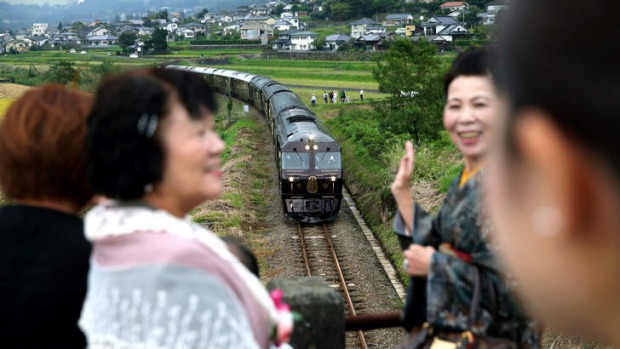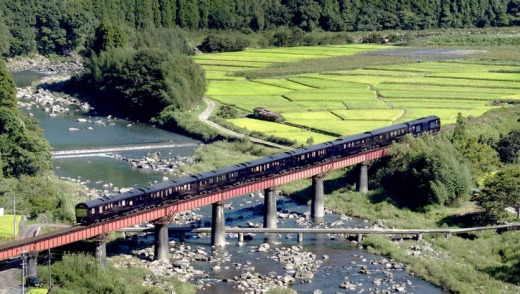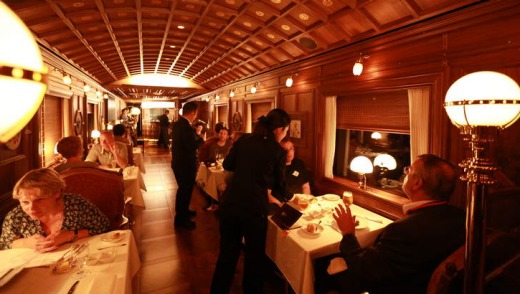
Japan's Seven Stars sleeper train takes luxury on wheels to new heights, writes Jamie Lafferty.
Kuniko is nervous. It's not her smile that betrays her, nor her steady English - it's her hand, which trembles as she pours me a coffee in the newly constructed Kinsei Lounge at Hakata Station. I don't think I'm responsible for her nervousness and after a year or so of training, you might think she should be more confident.
But Japanese national television station NHK has an enormous camera about a metre away from us, trained on our every move. Poor Kuniko, it's a hell of a way to spend the first few minutes of a new job. NHK is here to cover the maiden voyage of Nanatsuboshi, or Seven Stars, a new luxury sleeper train that tours around the western Japanese island of Kyushu. Its arrival is the biggest rail event to happen on the island since the 2004 launch of the shinkansen (bullet train). But this new train could hardly be more different.

The emphasis now is on taking time, absorbing the history and culture of Kyushu, if only for a few days. So where the shinkansen can speed from Hakata Station Fukuoka City in the north of the island to Kagoshima in the extreme south in less than two hours, the Seven Stars takes four days to do the round trip, taking in all seven of Kyushu's prefectures along the way. Where the bullet train lets commuters catch a brief nap between destinations, the seven carriages of the new luxury train share 14 suites, each with a different design, all fitted with en suite bathrooms and petite twin beds.
At one end there's a bar and restaurant car; at the other, two luxury suites share the final carriage. The very last of these is the most expensive, offering sensational views through the rear, all-glass wall. This suite will no doubt go on to host the great and the good, but for its maiden voyage, it hosts neither dignitaries, nor VIPs. For its first trip, it's hosting me and a funny English fella called Jon. We are two of a rag-tag group of European journalists, the first official Seven Stars passengers, here to cover its unveiling. This is strange for a number of reasons, not least because of the Japanese national press covering our departure. Are they jealous? Angry even? It's impossible to say, but we are on board and they are not - they can't even step inside for a quick look before we leave the station.
There are several reasons for JR Kyushu not entertaining the native media. Chief among these is that domestic demand was so enormous there was simply no need - every ticket on board every journey for the Seven Stars' first six months has already been sold and could have done so nine times over.

We have only found ourselves on board because company president Koji Karaike wants to promote his new baby to Westerners, as though their approval will validate his ambitious $30 million project.
From April next year, the train company will reserve two of the 14 suites for non-Japanese guests. Without this amendment, it would have taken years for foreigners to get on board. How has it been so wildly popular? Well for some Japanese, to be seen spending money is exceedingly important. This is a country that has more than $10 trillion of debt, twice its GDP, but in which Suntory can tap a 50-year-old barrel of whisky and have its $12,000 bottles sell out in hours. Earlier this year, businessman Kiyoshi Kimura paid more than $1.5 million for a fish, the first bluefin tuna of the new season at Tokyo's Tsukiji market. So financial doom, a falling population, unending economic pressure from China - what of them? There's a new, expensive train to ride? Great. President Karaike had wanted to build the Seven Stars for 25 years and within months of becoming president of JR Kyushu, he commissioned designer Eiji Mitooka to make it a reality. The result is a gorgeous wine-coloured train with gold emblems, the kind of thing that draws a crowd.
Now Karaike's guests have the choice between a fleeting two-day, one-night course that stays in the north of the island, and a longer, four-day course, with two nights on the train and one in a ryokan (traditional Japanese inn) in Kagoshima prefecture.
While the train doesn't go anywhere in a hurry, it doesn't spend too much time at any of its scheduled stops either. Japanese tourists are used to such brevity, but it may feel a little frustrating for foreign guests.
Take Nagasaki in the west of Kyushu, a city that's impossible to cover in a day, let alone in a few hectic hours. It was here in 1597 that 26 Christians were crucified as Japan moved towards its isolationist Sakoku period; but it was here too that the Dutch were allowed to trade when all other nationalities were forbidden.
For most people, however, Nagasaki is most famous for the apocalyptic horror of August 9, 1945, when the atomic bomb Fat Man was dropped, killing and maiming thousands, razing much of the city.
Curiously, though, none of those things are covered when visiting on the Seven Stars. Instead, the focus is largely on visiting Glover Gardens, former home of the Scottish industrialist Thomas Blake Glover, who helped revolutionise Japan when it finally reopened its doors to foreigners in the late 19th century.
High on a slope above Nagasaki's famous harbour, its views are unrivalled, the ornamental garden perfect. Presumably tourists, especially Japanese tourists who will always be the majority on Seven Stars, prefer this to ugly history.
Really, though, the excursions are little more than fillers between stints on the train. On board, guests eat the finest cuisine Kyushu has to offer and watch the island trundle past the window.
There are plenty of distractions, though perhaps not quite enough to get away from how impractical this handsome beast can be. When it came time for lights out, my roommate and I spent 20 minutes trying to find the light switch before eventually giving up and sleeping with them on.
The next morning we found out that at least three others had unscrewed the bulbs in frustration. While this perhaps doesn't say much for the intuition of the average Western journalist, surely such a simple task should have been much easier?
But you have to look hard to find fault with the train. Everything is immaculate, the attention to detail is sensational. The staff are handsomely turned out at all hours of the day, genuinely keen to help when they can, none more
so than the violinist and pianist duo. They take requests ahead of the journey, practise, then perform on board.
Before flying to Japan, I couldn't think of any songs that weren't faintly ridiculous, however Jon decided to request Guns N Roses' tour de force Sweet Child o' Mine. Amazingly, the duet dutifully bought the CD, listened to the track intently and memorised it by ear.
At night, after a lot of the other passengers had retired for the evening, we were lucky enough to hear their rendition. It was perfect. We howled along, large Japanese whiskies in hand, in love with the whole ridiculous concept.
Then they finished, we applauded wildly and clinked glasses, agreeing that, impracticalities and all, the Seven Stars is a really excellent idea.
The writer was a guest of JR Kyushu.
Bookings for foreign guests are now open, with the first spaces available in April 2014. Prices start from £970 each based on two sharing with all meals included. With a year's notice, the entire train can be booked for up to 30 people, with prices dependent on route and duration. For more details, including which suites are available to non-Japanese guests, see jrkyushu.co.jp/english/cruisetrain.